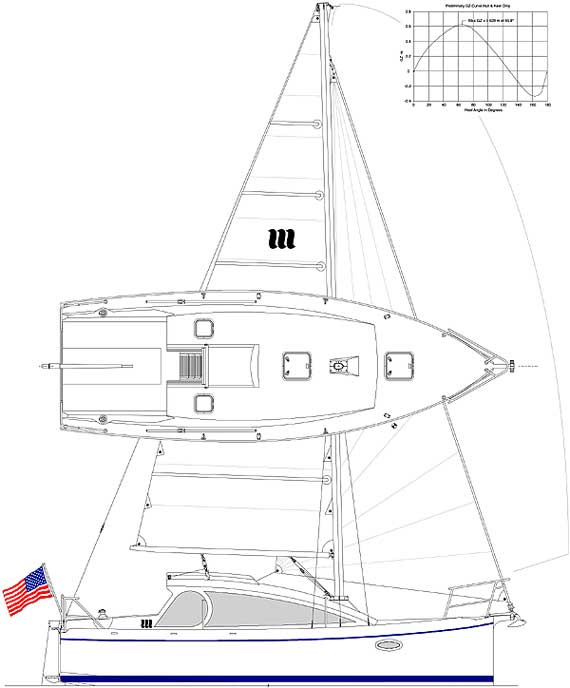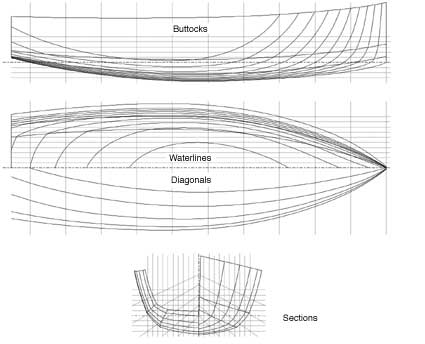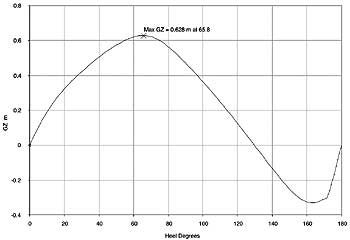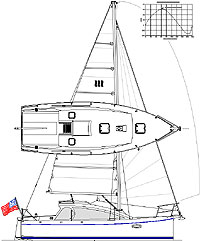| Preliminary Specification | ||
|---|---|---|
| LOA (inc. bowsprit) | 7.670m | 25'2" |
| LoD | 7.315m | 24'0" |
| LWL | 7.000m | 23'0" |
| Beam | 2.530 m | 8'4" |
| Draft | 1.000 m | 3' 3" |
| Displacement on dwl | 2180kg | 4806lbs |
| Ballast | 780kg | 1720lbs |
| Mainsail | 15.13m2 | 163ft2 |
| 100% Foretriangle | 13.13m2 | 141ft2 |
| Furling Genoa | 16.88m2 | 182ft2 |
| Headroom – saloon | 2.000m | 6'6" |
| Headroom – galley | 1.750m | 5'9" |
| Headroom – WC | 1.600 m | 5' 3" |
| Headroom – Fo'c'sle | 1.500m | 4'11" |
| Yanmar Inboard Engine | 6.7kw | 9hp |
| Outboard (in well) | 4.5-11.0kw | 6-15hp |
Design No. 160 – EasyBuild 24: 7.315m (24'0") sloop
Designed with cruising comfort in mind, the EasyBuild 24 can utilize all the benefits of CNC cutting to full advantage. Click the thumbnails below to see more detailed plans – they will open as PDF's in a new window.
The boat is built on nine ring frames which are made sandwich-style from 12mm ply CNC pre-cut parts. The parts are located accurately and easily by short lengths of dowel rod pushed through pre-bored holes. The layers are epoxy-bonded together, easily held down by weights or clamps. This system gives a smooth finish to the inside edges of the frames and a stepped bevel on the outside edge to suit the hull, deck and superstructure angles. The little steps are easily filled by the epoxy bonding the skin panels on.
The main structural longitudinal elements – the backbone, stem and sternpost – are also made and assembled sandwich-style like the frames, from CNC cut plywood components.
The hull skin panels are CNC cut sections and can be joined into full lengths off-the-job using our finger jointing system which ensures accuracy and strength. Alternative CNC files provide for the sections to be butt joined (with a butt strap) or scarphed to each other which can be done section-by-section on the boat, which makes manoeuvring them easier if the builder has limited personnel to help.
Other elements such as deck panels, coamings, the coachroof top, the cockpit sole, sides and seats, engine beds, the interior furniture items, soles and so on, can also be CNC cut, often for sub-assembly off the boat.
We have done some modeling this design in 3D, building our virtual boat directly from models of the various components as they are drawn for CNC cutting. Early stages of the modeling process are shown in this slideshow. When it loads it will be on "Pause"; hit "Play" to set it going or move manually backwards and forwards through the slides. When you close the window, it's best to leave the slideshow on Pause else it will still be running in the background
Now let's take a look at some of the principal features of the design:
Comfortable Civilized Accommodation at Sea and in Harbour:
- Full standing headroom (2.000m, 6' 6") in the main saloon.
- Good headroom in the galley (1.750m, 5' 9") and WC compartment (1.600m, 5' 3").
- Pretty good headroom in the fo'c'sle (1.500m, 4' 11")
- Good visibility out when seated in the main saloon.
- Separate private fo'c'sle with hanging locker; v-berths can make a double with simple infill.
- Great sea-going galley with sink, refrigeration and plenty of lockers.
- Separate WC compartment with toilet, washbasin and good lockers.
- Spacious main saloon with good handholds and comfortable settees – designed with both harbour and at-sea use in mind. Settee's can convert to a double berth if required.
- Comfortable quarterberths – absolutely the best berths when at sea.
Simplicity, Safety and Stability:
- Easily accessible diesel auxiliary for safe and reliable power.
- Optional – as an alternative – outboard motor can be mounted in well in cockpit.
- Fixed ballast keel gives permanent stability with reasonable shoal draft
- Transom-hung rudder is economical, simple and easy to maintain.
- Straightforward no-hassle modern rig is simple, fast, easy to handle and effective.
Construction:
- Soft-chine hull gives all the performance benefits of a chine hull aft with the sea-kindly easy-riding round-bilge hull forward.
- All developable panels so everything can be cut from flat ply sheets.
- Components CNC cut from 12mm ply gives fast build, accuracy, simplicity, economy and a professional finish.
- Proprietary joining and assembly methods give super-fast and accurate set-up and build.
The accuracy of the pre-cut parts is the key to assembling the boat quickly and easily. Once the hull is formed, other parts mostly slot into place without a lot of complicated measuring and levelling. Most often, if something fits it is in the right place; if it doesn't, then it's not.
The parts will usually be "nested" by the CNC cutting company. This means that they nest parts together to get the most economical usage out of the material. This is also why we design each boat as far as possible to use one thickness of ply. So when nested, parts are not necessarily arranged in logical groups. Originally we thought this might be a problem, but somewhat surprisingly, it didn't turn out that way – parts are mostly easily recognizable and can be extracted one by one from their sheets of ply as needed. Parts can be labelled by the CNC cutting facility but this is usually quite expensive and we have found it not to be necessary. Our DXF files are arranged in logical groups, so you don't necessarily have to get everything for the whole boat cut at once, which does make part identification easier.
Although intended primarily for construction from CNC cut parts, there is no reason why most of the parts can't be marked out and cut by hand. An exception to this are the parts for the frames, which would be tedious to mark out and cut by hand. We will be providing an alternative set of frames constructed from solid and laminated timber elements. The backbone can also be laminated up from solid timber and then bevelled off to suit the hull angles as with many of our other designs.
Note: This design is currently (Oct 2024) on hold as my colleague who is carrying out the modeling has had to take a break because of a career change. We will be returning to the design as soon as we can.









